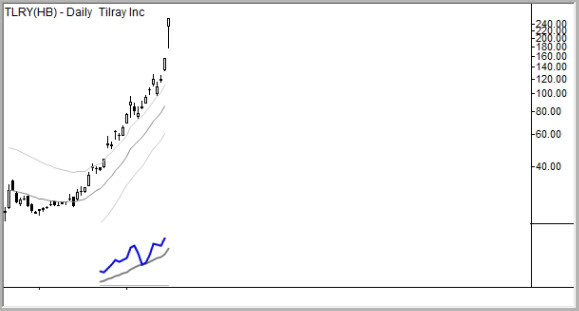TLRY and other Pot stocks: trading extreme moves
Pot stocks are the new cryptocurrencies, at least in terms of volatility and bubble potential. Take a look at the chart of TLRY below.

A few thoughts:
- First, this chart is log-scaled. (One good reason to use log scaling instead of linear scaling is when there is a very large price range on the chart. Log scale charts tend to compress action at higher prices in order to expand price action at the lower end of the range. This makes this explosion, in a recent IPO, even far more dramatic than it appears on the chart!
- Volatility is extreme. 20 day HVol is about 177%. (Meaning that a one standard deviation expectation of price over the next year is +/- 177% of the current price. For comparison, NFLX sits at about 44%, LULU at 50%, FB at 22%, and SPY about 6%.)
- All technical measures are off-the-charts (almost literally) overbought/overextended. Chart patterns are less reliable when single days can exceed the entire prior trading range of the stock.
So how do we trade something like this?
Well, realize first of all that this is a dangerous market. Most people who get into stocks like this will completely lose discipline as dreams of turning a few thousand into a few million start to take shape. If you’re going to get in and get out with some money, you will need to stand apart from the crowd and act at extremes.
Where are the extremes? Here’s the bad news: no one knows. After the fact, people will show you technical tools that would have worked, but there’s no way, at the hard right edge of the chart, to say when a move is likely to end. This stock could be $50 or $500 tomorrow. No one knows, and anyone talking about it is likely 1) highly emotional, 2) talking their book, and 3) not an experienced trader. You cannot listen to anyone else.
FOMO (fear of missing out) reigns supreme here. If you log into any social media platform, it will seem everyone else is making a lot of money and that you better get in too. Realistically, I’ve seen this scenario dozens of times in my career and most of those people will end up with nothing when the ride is over. Again, you have to stand apart from the crowd.
If you are a daytrader, stocks like this may offer some good opportunities. If you are not an experienced daytrader, stocks like this will offer some good opportunities for you to become food for better traders.
A few practical guidelines:
- Stay small. If you want to play in a stock like this, you don’t have to put all your chips on the table.
- Stay focused. Assume that anyone telling you anything about a market like this does not know what they are talking about. Listen only to yourself and follow only your trading plan.
- Take partial profits along the way. Don’t try to sell the exact high all at once. If you have solid profits and you find yourself getting emotional, sell some. Sell down to the point where your emotions settle down.
- Be very careful of adding to your position. Assume that trading a stock like this is basically like cuddling a hand grenade. Adding to the position is pulling the pin. There are a lot of ways this scenario can go wrong, and not many ways in which it can go right!
- Don’t expect a stock like this to follow any rules. If you find yourself convinced the market is wrong, you are wrong. Again, sell some more until you get less emotional.
- If you want to short something like this, chances are you are not wrong. But if you are wrong on the timing, you could be out of business. It’s much harder than it looks when something can make a casual 100%+ move against your short before turning around. Stay small. Plan on pain. If you get some profits, cover some of the position until you are less emotional…
There’s nothing wrong with avoiding stocks like this. If you wish to play, it’s a different kind of trade. (Everything I wrote here could have applied equally well to cryptocurrencies in recent memory.)
The psychology of a FOMO-driven market is a bit different. It’s like everything you’ve ever experienced in markets, but made much bigger, much more intense, and much more in every way! Notice that my suggestions focus on controlling your emotions, avoiding the hype, and doing both of those things through regulating your position size.
There may be other answers to trading a market like this, but these are guidelines that have served me well. I don’t mean to suggest you can’t make money in a market like this—you can, but you can also get hurt badly. Most traders who trade markets like this will end up losing.
Be careful, my friends. Focus on the risk and the mistakes you might make, and let the upside take care of itself.



